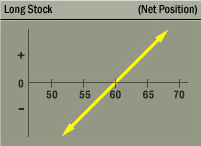Long Stock
This strategy is simple. It consists of acquiring stock in anticipation of rising prices.
Description
This strategy simply consists of buying shares of the underlying stock. The purchase price sets the cost basis, and the exit price establishes whether there is a net profit or loss on the asset. No gain or loss is final until the stock is actually sold. (However, once received, dividend income of course belongs to the stockowner.)
Stock exit plans vary widely and are not very relevant to an options text. It's enough to note two examples here. One system is to buy and hold stock indefinitely; exit occurs only if the fundamentals change significantly. Other investors re-evaluate each equity against performance targets, asset allocation goals or at certain time intervals, and then sell the ones that seem overweighted or overvalued.
Factors such as tax considerations or employment-related stock holding rules could also affect the timing and desirability of a sale. Stock owners who want to lock in existing gains without liquidating the equity may be candidates for an option hedge.

EXAMPLE
- Long 100 shares XYZ stock
MAXIMUM GAIN
- Unlimited
MAXIMUM LOSS
- Purchase price of stock (substantial)
Outlook
The investor is bullish on the stock and/or the equity market as a whole.
Some buyers are bullish in the long term, while others act in expectation of short-term gains. It is the investor's decision whether to buy and hold indefinitely, or to trade in and out in hopes of a quick profit.
If an investor is bullish in the longer run but very concerned about a near-term correction, there may be other, more suitable alternatives than a standalone long stock strategy.
Summary
This strategy is simple. It consists of acquiring stock in anticipation of rising prices. The gains, if there are any, are realized only when the asset is sold. Until that time, the investor faces the possibility of partial or total loss of the investment, should the stock lose value.
In some cases the stock may generate dividend income.
In principle, this strategy imposes no fixed timeline. However, special circumstances could delay or accelerate an exit. For example, a margin purchase is subject to margin calls at any time, which could force a quick sale unexpectedly.
Motivation
The stock buyer hopes to profit from gains in the stock's price, and, sometimes, with dividend income.
Stock selection itself could be based on any number of reasons: a personal interest in this specific stock, employer incentives to accumulate shares, or a desire to diversify a portfolio, for example.
Variations
Stock can be acquired by various means: e.g., via a direct cash purchase, or through an employer, an inheritance, or a margin purchase. The method could dictate a different way of establishing a cost basis and/or restrict the timing of an exit. For purposes of this summary, the investor is assumed to be buying a stock outright, in the market, for cash.
Max Loss
The entire acquisition value is at risk. The worst that can happen is for the stock to become worthless, in which case the entire investment has been lost.
Max Gain
Profits rise along with the stock's value. Theoretically, the best that can happen is for the stock to rise to infinity, in which case the gain would also be unlimited.
Dividends, if there are any, add to the net profit.
Profit/Loss
There is no upper limit to the potential for profit.
By the same token, potential losses are also substantial; if the company goes bankrupt its stock could fall to zero, for a total loss amounting to the initial cost, less any dividends received to that point.
Breakeven
This strategy breaks even when the stock is trading at the price paid at the outset.
Breakeven = purchase price of stock
(An aside worth noting here: This strict definition of breakeven obviously ignores the time value of money. If a stock trades at its acquisition price years later, the result has to be seen as an economic loss, because of the capital the stock ties up and the risks involved.)
Volatility
The concepts of volatility and especially implied volatility don't apply quite in the sense that they do to option positions. However, if the stock becomes more volatile, it increases the potential for larger losses as well as larger profits. And if the stock has been purchased on margin, it increases the likelihood of having to meet margin calls.
Time Decay
Not relevant.
Assignment Risk
None.
Expiration Risk
None.
Comments
Though the concept of time decay does not apply to stock, the passage of time is a consideration for a stock buyer. Since owning stock ties up capital, the investor incurs an opportunity cost while holding the stock. That could be one consideration in evaluating alternative bullish strategies.
On a different note, stock can sometimes be acquired on margin. Margin availability is governed by regulatory constraints as well as the brokerage firm's internal guidelines, which may be more stringent. The investor must secure all necessary preapprovals first. Also, margin purchases are subject to margin calls. Please consult your brokerage firm to learn more about margins.
Related Position
Comparable Position: Synthetic Long Stock
Opposite Position: Short Stock

